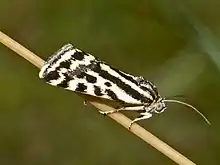Emmelia trabealis
Emmelia trabealis, the spotted sulphur, is a moth of the family Noctuidae. The species was first described by Giovanni Antonio Scopoli his 1763 Entomologia Carniolica.[1][2]
| Emmelia trabealis | |
|---|---|
 | |
 | |
| Scientific classification | |
| Kingdom: | |
| Phylum: | |
| Class: | |
| Order: | |
| Family: | |
| Subfamily: | |
| Genus: | |
| Species: | E. trabealis |
| Binomial name | |
| Emmelia trabealis | |
| Synonyms | |
|
List
| |
Taxonomy
The species is sometimes placed in the genus Acontia and Emmelia is considered as a subgenus of Acontia.
Distribution
The spotted sulphur can be found in most of the Palearctic (Europe, North Africa, the Middle East and Russia to northern China and Japan).[3][4] It was formerly resident in Great Britain, but has not been seen at any known breeding colonies since 25 June 1960 and is presumed extinct there.[5]
Habitat
This species prefers sandy soil, dry and warm areas, meadows and sunny slopes on which the bindweed occurs.
Description
The wingspan of Emmelia trabealis can reach 18–24 mm. The forewings show a very variable black drawings on a yellowish or dirty white background. The rear wings are reddish brown.[5]
Eggs are green, elongated and cone shaped, with a flattened base and distinct longitudinal ribs. Caterpillars are reddish to greenish brown, with dark dorsal lines and a yellow side band, the head is relatively small and brown. Cocoons are red brown or green.[5]
Technical description and variation
E. trabealis Scop. (= sulphuralis L., arabica Hufn., sulphurea Schiff., trabeata Scriba, lugubris F., pardalina Walk.) (52 g). Forewing pale yellow; the markings black, edged, when fresh, with lustrous scales;horizontal black streaks from base along median and submedian veins; the lines marked by black costal spots, the outer and subterminal more or less complete, sometimes interrupted; two black spots represent the stigmata; fringe yellow marked with black in middle and at each end; hindwing reddish fuscous; the fringe yellowish white. The insect varies according to the preponderance of the yellow or black scaling; as a rule, the yellow prevails in the female, the black in the male; — the ab. nigra Ersch. (52 g), from W. Turkestan, is almost wholly black. Larva green changing to brownish; dorsal and subdorsal lines darker, with faintly paler edges; spiracular line broadly pale yellow.[6]
Biology
This species presents two overlapping generations a year, the second generation is generally missing in cool years. The moth flies from May to August depending on the location and then again from August to early September. The pupa overwinters. The larvae feed on field bindweed (Convolvulus arvensis)[5][7] and Polygonum species.[3] The imago takes short jerky flights in the sunshine close to the ground and is difficult of observation; it frequents dry and sandy localities.
Gallery
_trabealis_MHNT_dos.jpg.webp) Male - dorsal side
Male - dorsal side_trabealis_MHNT_ventre.jpg.webp) Male - ventral side
Male - ventral side
Bibliography
- Arno Bergmann: Die Großschmetterlinge Mitteldeutschlands. Band 4/2, Eulen. Urania-Verlag, Jena 1954.
- Borkhausen, 1790, Naturgeschichte der Europäischen Schmetterlinge nach systematrischer Ordnung 3. Der Phalaenen erste Horden, die Spinner: pl. 10, fig. 8. TL: Europe.
- Denis & Schiffermüller, 1775, Ankündung eines systematischen Werkes von den Schmetterlingen der Wienergegend: 93. Unjustified emendation of Phalaena trabealis Scopoli, 1763.
- Fabricius, 1793, Entomologia Systematica, Emendata et Aucta 3 (1): 467. TL: Europe.
- Günter Ebert (Hrsg.): Die Schmetterlinge Baden-Württembergs. Band 5, Nachtfalter III (Sesiidae, Arctiidae, Noctuidae). Ulmer Verlag, Stuttgart 1997. ISBN 3-800-13481-0.
- Manfred Koch: Wir bestimmen Schmetterlinge: III Eulen Deutschlands. Neumann Verlag, Radebeul & Berlin 1958.
- Scopoli, 1763, Entomologica Carniolica Exhibens Insecta Carnioliae Indigena et Distributa in Ordines, Genera, Species, Varietas Methodo Linnaeana : 240
- Walker, 1865, List. Spec. Lep. Ins. Colln. Br. Mus. 33: 794. TL: Mauritius. HT: BMNH. male.
Walter Forster & Theodor A. Wohlfahrt: Die Schmetterlinge Mitteleuropas. Bd. IV, Eulen (Noctuidae). Franckh’sche Verlagsbuchhandlung, Stuttgart 1971, ISBN 3-440-03752-5.
References
- NCBI
- BioLib
- Naturkundliches Informationssystem
- Fauna Europaea
- Waring, Paul; Townsend, Martin & Lewington, Richard (2003). Field Guide to the Moths of Great Britain and Ireland. British Wildlife Publishing, Hook, UK: 378.
- Warren. W. in Seitz, A. Ed., 1914 Die Großschmetterlinge der Erde, Verlag Alfred Kernen, Stuttgart Band 3: Abt. 1, Die Großschmetterlinge des palaearktischen Faunengebietes, Die palaearktischen eulenartigen Nachtfalter, 1914
 This article incorporates text from this source, which is in the public domain.
This article incorporates text from this source, which is in the public domain. - Savela, Markku, ed. (31 May 2020). "Emmelia trabealis (Scopoli, 1763)". Lepidoptera and Some Other Life Forms. Retrieved 21 September 2020.
External links
| Wikimedia Commons has media related to Emmelia trabealis. |
- Kimber, Ian. "73.029 BF2414 Spotted Sulphur Acontia trabealis (Scopoli, 1763)". UKMoths. Retrieved 21 September 2020.
- Mazzei, Paolo; Morel, Daniel & Panfili, Raniero. "Acontia (Emmelia) trabealis (Scopoli, 1763)". Moths and Butterflies of Europe and North Africa. Retrieved 21 September 2020.
- Lepiforum e. V.
- Portal für Schmetterlinge und Raupen